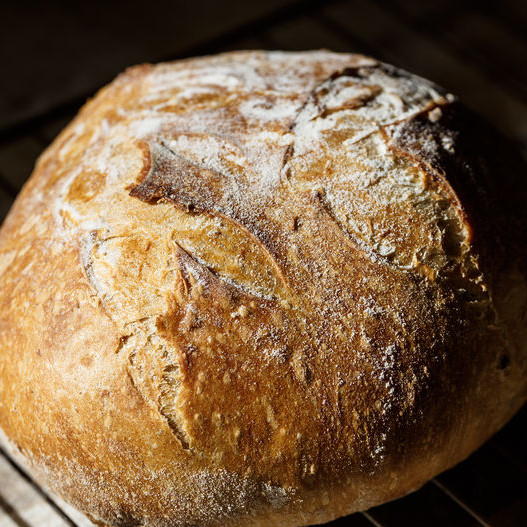
Artisan Bread
Also Known as Handmade Bread
What is Artisan Bread?
Artisan bread is a term that has no absolute definition but refers to a style of short shelf-life bread that is usually offered unpackaged (in baskets) and consumed immediately after baking for maximum freshness.
Usually produced in small factories, artisan bread is characterized by being:
- Made by hand using traditional processing techniques
- Higher water absorption levels
- Lean formulations
- Pre-ferments
- Longer fermentation times compared to commercial pan bread and rolls
This category of bread is becoming more important in the baking industry as customers are looking for products with different and creative designs, maximum freshness and clean labels.
Origin
The term artisan bread conjures the image of artisan bakers who are masters of their craft, shaping breads by hand and only using the basic bread ingredients: flour, water, yeast, salt, and most importantly time. This is a stark contrast to the standardized, repeatable and industrially-produced breads that are often found in the supermarket bread aisle.
How does it work?
The term artisan bread can include hearth breads (those baked without pan), and sourdough breads. The following are some examples:
- Baguette
- Ciabatta
- Focaccia
- Naturally leavened multigrain bread
- Naturally leavened white bread
- Panettone and brioche (enriched artisan type)
Artisan breads are usually baked in hearth-style ovens (with radiant heat as main source of heat transfer), and ovens that are designed to inject/exhaust steam into/from the baking chamber. This type of bakery products are usually crusty, with a large and open cell structure. They also have a rustic look, ornate scoring and/or flour dusting on top.
How are artisan breads made?
Artisan breads are characterized by their lean formulation (i.e. low sugar and fat level), little to no use of dough conditioners (except for enzymes used for dough strengthening and crumb softening), and high or low hydration levels (depending on shape and spread desired by the baker).
The following are some ingredients available for the production of artisan bread and their usual levels in the formula:1,2,3
| Ingredient | Baker’s % |
| Bread flour* | 100.0 |
| Whole wheat flour** | Any level / 100.0 for whole wheat bread |
| Rye flour (dark, medium or light) | 20.0–40.0 |
| Semolina flour | Any level (depending on particle size) |
| Cracked or crushed whole grains | Any level (depending on particle size) |
| Water | 50.0–85.0 |
| Compressed yeast (optional if using pre-ferments or sourdough) | 0.1–3.0 |
| Biga / poolish / sponge | 15.0–50.0 |
| Sourdough | 15.0–50.0 |
| Virgin olive oil (flavor and color) | 1.0–2.0 |
| Non-diastatic malt (color and flavor) | 1.5–2.0 |
| Sugar (refined, granular sucrose) | 0.5–1.0 |
| Salt (usually delayed during mixing) | 1.5–2.0 |
* Protein content 12.5–14.0%, ash content 0.45–0.55% (depending on flour extraction and wheat class).
** Protein content >14.0%, ash content 1.5–2.0%.
Comparison of artisan to commercial breads
Formulation
- Flour: “True artisan” breads use wheat flours with a lower protein content (10.0–10.5% on a 14.0% moisture basis) but superior quality such as hard red winter wheats to produce chewy texture and open grain without toughness. Commercially produced artisan bread often requires higher protein flours to withstand dough machinability.
- High water amounts: the resulting higher hydration doughs will be slack and sticky and can only be handled by hand or specialized equipment.
- Biochemical leavening: baker’s yeast, wild yeast, naturally occurring lactic and acetic bacteria. Longer fermentation times of these microorganisms provide unique flavor, aroma and volume development at lower concentrations.
- Preservatives: artisan bread doughs are fermented to low pH’s (4–5) which acts as a natural preservative.
Processing conditions:
- Fermentation: bulk for about 24 hours at room conditions of T°/RH.
- Mixing: shorter mixing time due to lower tolerance/stability of the low protein dough and its high acidity.
- Makeup (dividing, rounding, moulding): application of very gentle stress and strains on the dough piece to preserve the open cell structure and gassiness.
- Proofing: intermediate to long proofing/resting times to allow the dough to recover from mechanical work.
- Dusting flour: higher amounts to reduce stickiness and improve handling of high absorption doughs. It can also provide distinctive appeal to baked goods.
- Baking in hearth ovens loaded with peel board: injection of steam for 20–35% of bake time. Time/temperature profile depends on scaling weight, size and desired crust of finished product.
References
- Wirtz, R.L., and MacGuire, J.J. “Flour” The Taste of Bread, Springer Science+Business Media New York, 2001, pp. 3–14.
- Finnie, S., and Atwell, W.A. “Composition of Commercial Flour.” Wheat Flour, 2nd edition, AACC International, Inc., 2016, pp. 31–48.
- Gisslen, W. “Lean Yeast Doughs: Sponges, Pre-ferments, and Sourdoughs” Professional Baking, 7th edition, John Wiley & Sons, Inc., 2017, pp. 155–179.

